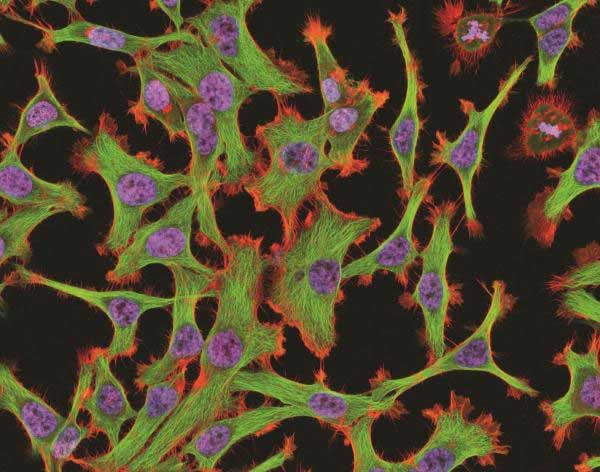Human Tumor Cell Lines
Tumor cell lines (or cancer cell lines) are derived from the cancerous growths on an organ in a human or animal subject. These cell lines have undergone laboratory modifications that render them immortalized—they are capable of proliferating indefinitely in an in vitro environment. For that reason, tumor cell lines have become invaluable tools in the field of cancer research.
History of Human Cancer Cell Lines
In the first half of the 20th century, various experiments demonstrated that animal cell lines could be maintained in an in vitro environment. The first human cell line was established in 1951, from cervical carcinoma cells taken from 30-year-old Henrietta Lacks. The HeLa cell line, as it’s called, is regarded as a major milestone in medical history, being not only the first immortalized cell line but also an important aid in the development of the polio vaccine.

In 1990, the U.S. National Cancer Institute officially launched the NCI-60 project, which consists of sixty distinct human cancer cell lines that can be used to identify pharmacological compounds that may have anti-cancer properties. Nine distinct human cancers are represented in this grouping: breast, central nervous system, colon, kidney, leukemia, lung, melanoma, ovarian, and prostate. The NCI-60 project has provided cancer researchers with many important insights into drug-tumor interactions.
Today, literally hundreds of human cancer cell lines have been established, including MCF-7 (breast adenocarcinoma), HT-29 (colon adenocarcinoma), HEP-G2 (hepatocellular carcinoma), A549 (lung carcinoma), K-562 (chronic myeloid leukaemia), and A375 (malignant melanoma). These and other immortal human cell lines are the primary models used in the modern laboratory to study cancers.
Benefits of Cancer Cell Lines
Cancer cell lines continue to yield multiple important research benefits, and there is little doubt that they will be a laboratory mainstay for many years to come. Chief research benefits of cancer cell lines include:
Large variety – With literally thousands of human and animal cancer cell lines available, representing a wide array of biological origins, researchers have plenty of options to select from.
Ease of use – Researchers can manipulate cancer cell lines in a number of ways, including the use of demethylation agents (to inhibit methylation) and cytostatics (to inhibit cellular growth).
Similarity to tumor – When properly maintained, cancer cell lines retain most—but not all—of the genetic and epigenetic information associated with the original in vivo tumor.
Experimental flexibility – Cancer cell lines allow researchers to perform experiments that cannot be carried out in an in vivo environment.
Applications for Human Cancer Cell Lines
Cancer cell lines have multiple uses in a laboratory context, such as:
Tumor analysis – Tumor cell lines allow researchers to identify and analyze the genes that characterize different cancer subtypes, which is important for developing targeted treatments.
Drug research and testing – Cancer cell lines have, for instance, led to key insights relating to the uses of proteasome inhibitors in treating multiple myeloma.

AcceGen offers researchers over 1,000 human tumor cell lines, including melanoma, lymphoma, leukemia, sarcoma, breast cancer, pancreatic cancer, gastric cancer, and ovarian cancer cell lines. Please visit our website for more information on human tumor cell lines. AcceGen can also be reached by email at inquiry@accegen.com.
About AcceGen
A biotech company founded in 2016, AcceGen provides high-quality genomic research solutions to researchers and organizations in the fields of pharmaceutics, biotechnology, cell biology, and specialty ingredients. AcceGen is located in Fairfield, New Jersey.
Comments
Post a Comment